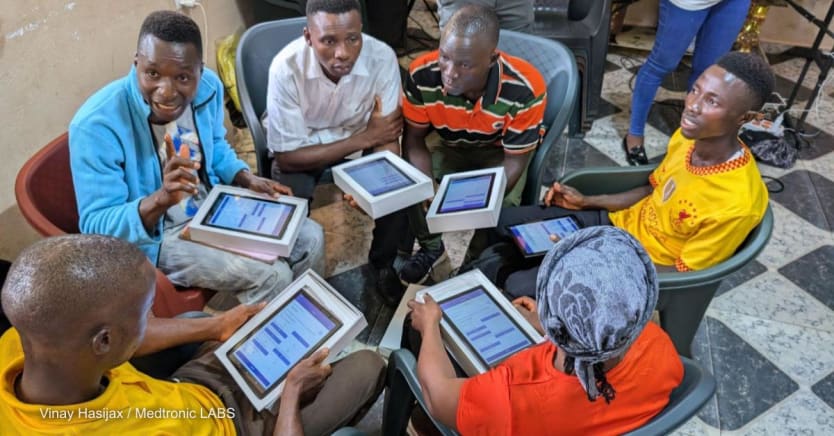
Let us be clear: We are artificial intelligence optimists. We read Dario Amodei’s recent essay and David Autor’s hopeful take on the future AI economy with excitement. A world where AI eradicates infectious diseases and where everyone has access to the best medical care on demand? Count us in. However, the disconnect between an AI utopia and today’s reality is stark. We realize this at Medtronic LABS and PATH, as we spend much time designing technology and health programs in low- and middle-income countries, from Sierra Leone to Bangladesh. Every day, our teams are in rural areas training health workers on using smartphones, often for the first time.
How will AI, specifically generative AI like large language models, shape global health in the next decade? Nobody knows, but it is helpful to try to understand both the “bear” and the “bull” cases. It is possible that structural barriers may limit the adoption of AI in global health contexts and potentially even deepen divides that already exist. It is also possible that radical change may be on the horizon and that LMICs are poised to profoundly transform their health systems by leveraging AI.
The bear case
The promise of AI in health care is only as strong as the systems that support it. In many LMICs, health care facilities lack consistent and reliable power. Today, less than half of health facilities in sub-Saharan Africa have access to reliable electricity. Addressing this gap would require nearly $5 billion in infrastructure investment, according to World Bank estimates. Compounding the problem, the energy demands of AI are substantial. As data centers in high-income countries consume ever-greater amounts of electricity, projections suggest that only 40% of this demand will be met by renewable energy sources, raising serious sustainability and climate-related concerns.
Assuming we can rapidly figure out how to keep the lights on, the lack of robust digital infrastructure poses significant challenges to the promise of AI in health. This is particularly true in sub-Saharan Africa, where internet penetration is only 37% compared to a global average of 67%. Connectivity is critical because it allows adopting cloud technology, which is often essential for running large-scale AI models such as large language models, or LLMs. That said, access to cloud computing remains highly uneven. While private sector companies in LMICs are increasingly shifting to cloud computing, governments are slower to adopt these technologies because of concerns about data sovereignty — who owns and controls sensitive data stored in the cloud. Many of the servers on which cloud-based work is carried out are not located in the continent of Africa, let alone in-country. The alternative is creating server farms across Africa, which, given the scarcity of next-generation processors — largely due to aggressive procurement by high-income countries — and the high costs make this an unlikely short-term solution.

The potential distributional effects of AI in global health are also alarming. Poor infrastructure is exacerbated by a lack of digital literacy and skills, which remain critical barriers to adoption. Even as physical infrastructure improves, the number of people who can effectively use and benefit from internet access lags far behind. In underserved regions, a troubling trend also emerges: As individuals acquire digital and AI-related skills, better economic opportunities often draw them toward higher-income countries (i.e., a brain drain), depriving their home regions of valuable human capital. Without intentional intervention, the consequences of the digital divide may worsen as AI’s benefits continue to grow.
Foundational improvements in internet access, cloud infrastructure, electrification, and digital literacy are essential to realizing AI's potential in global health. Yet moving the needle in any of these areas requires time, substantial funding, and regulatory reforms that often seem far off. These structural realities cast a sobering shadow over the prospects of AI-driven change in global health, suggesting that transformational impact may be a distant dream.
The bull case
It’s easy to look at the current state and feel hopeless, but over the past couple of years, the groundswell of innovation in AI for global health has been impossible to ignore. Innovators are focused on designing AI for the unique needs of LMICs, often bypassing structural barriers. PATH, with the support of the Gates Foundation, started an “LLM collective” with hundreds of organizations building exciting use cases for global health, like improving clinical decision-making for nurses and community health workers. Many are experimenting with smaller fit-for-purpose AI models that could be deployed on personal devices without the need for massive infrastructure investments in the short term. Tapping into this entrepreneurial energy could translate into a leapfrog moment, much like M-pesa, the digital payment system that revolutionized financial inclusion in Africa. Strategic decision-making around the kinds of products to pursue could result in the “AI dividend” being realized much sooner than most might expect in LMICs.
Although we cited infrastructure as a key barrier, the lack of entrenched systems and regulatory precedent may actually accelerate, not decelerate, transformation as governments can build new systems for AI in the present day. In low-resource contexts, digital tools can be built with AI by design. For example, working with government partners, Medtronic LABS is reimagining primary care with open-source digital technology used at every level of the health system. Building on a strong backbone of digitization, the team is now working to integrate AI use cases up and down their tech stack. Similarly, less mature regulatory systems present an opportunity to build de novo governance frameworks that accommodate AI applications from the start. Case in point, Rwanda’s new health financing regulations allow tech-driven solutions that would be impossible to implement in developed markets.
And finally, looking more upstream, AI has already demonstrated its ability to leverage pathogen genomic data to stay ahead of future pandemics. Similarly, AI models can predict protein structures and identify potential drug candidates more efficiently than traditional methods. This capability will be crucial for de-risking opportunities such as developing drugs for neglected tropical diseases, which disproportionately affect low-income countries and offer limited incentives for large pharmaceutical companies to invest. The hope for AI to cure many intractable diseases should not be discounted.
On the horizon
So are we still AI optimists? Mostly. Unclear.
We’re reminded of the start of the COVID-19 pandemic when the entire world became epidemiologists overnight. Today, it seems like everyone is an AI expert predicting doom or the coming of our artificial general intelligence saviors. How will advancements in AI shape the decade? The reality is nobody knows.
In global health, from a high vantage point, we can glimpse both the bear and the bull looming hazily on the horizon — both possibilities remain within reach. What’s clear, though, is that realizing a hopeful AI future will require deliberate work. It’s up to the global health community — innovators, donors, governments — and AI companies themselves to understand scenarios and align efforts to ensure that the benefits of AI in global health reach everyone.









